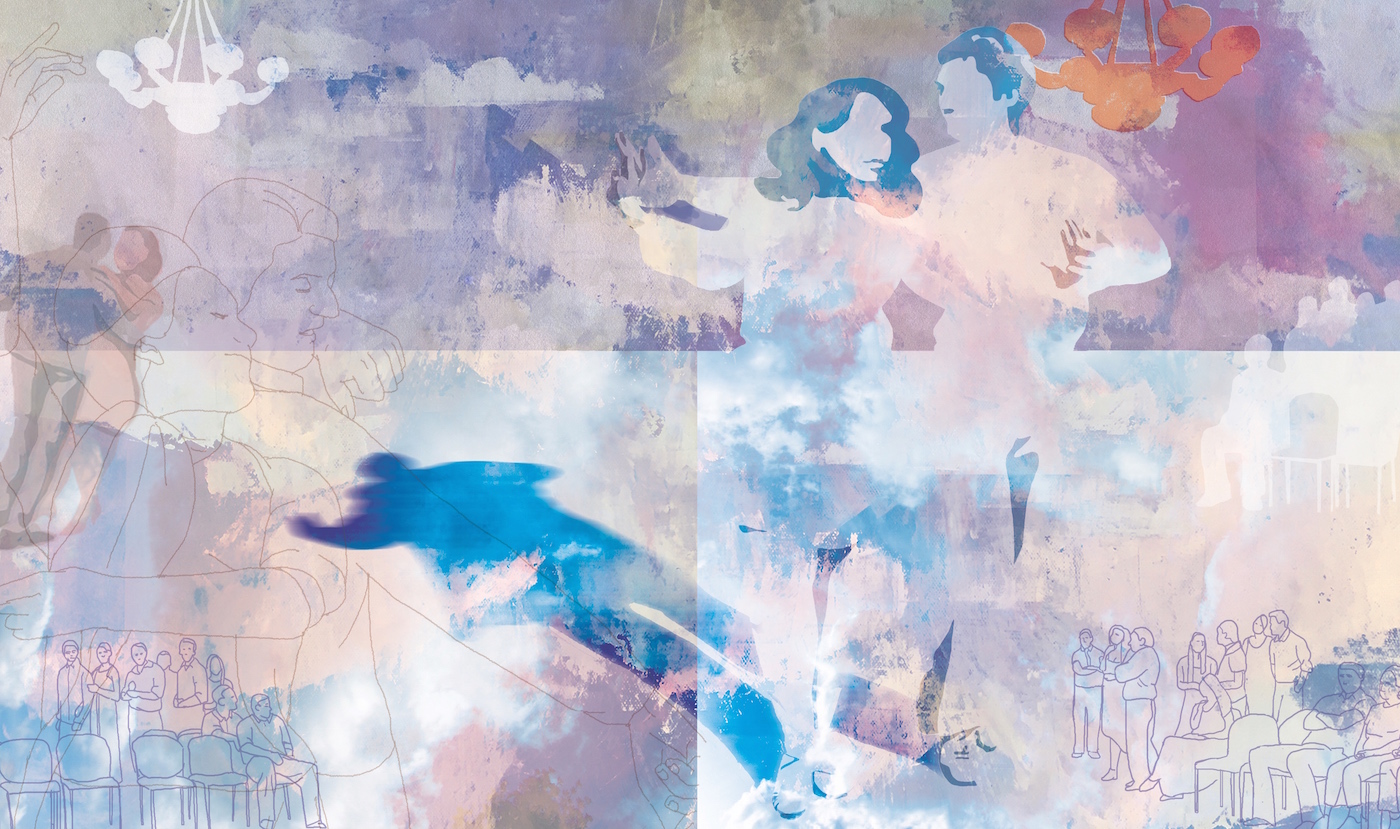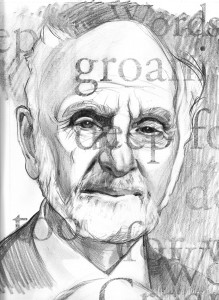
Worship. Theology. Art.
These words don’t naturally roll off the tongue together. One might be able to understand the pairing of worship with theology, or art and worship—even art and theology—but together they seem like three adopted children from different families rather than a natural fit. Yet for ten years now Fuller’s Brehm Center has existed at the crossroads of worship, theology, and art and has found it not only a busy intersection, but one filled with important and unknown insights.
As it is part of a theological seminary, the Brehm Center exists not for the pleasure of considering insights gleaned by mating these theological categories, but for scholarly research and pastoral application of that research. We offer graduate education to women and men preparing for a wide variety of ministries. To accomplish this, we have had to develop theological methods for researching and teaching in the confluence of these fields of interest. What follows is a brief introduction to the world we inhabit at the intersection of worship, theology, and art.
Augustine and the Art of Communication
One of the cornerstones of our work in this emerging field rests in the theological musings of an early architect of Christian theology. St. Augustine was fascinated by a question: How is it that a person could have an idea in one’s head and get that idea into the head of another person? How can one communicate what he or she is thinking to another? Augustine believed that before humanity’s fall from grace, we were able to communicate directly with one another and with God. But since the Fall, we have been incapacitated by our sinful state and now are limited to the confines of our bodies. Now all we have with which to communicate are signs, words, gestures, and sounds. In his early treatise On the Teacher, Augustine raised this question as a matter of how one teaches and how one learns. He also explored this question in terms of music. In On Music, a treatise written about the same time, Augustine argued that music, particularly rhythm, is the grammar of sound, giving it structure and meaning. In this way Augustine stretched his rhetorical training and its emphasis on words and broadened language to horizons beyond the verbal to symbols, gestures, and sounds—all of which are vehicles for communication between human beings and between humanity and God.
Augustine mused that God might be able to communicate to us directly, but has chosen to operate within the limits of our sinful nature. For this reason, God spoke through events (burning bushes), visions (Jacob’s vision of a stairway to heaven), people (prophets), and, finally, through the incarnation of Jesus Christ. In each of these ways God has chosen to communicate using verbal and nonverbal communication, engaging the entirety of our humanity.
This has some very practical applications as it addresses the nature of our everyday communication. For example, if I wanted to communicate to you “hot fudge sundae,” I could give you a hot fudge sundae and then you would know exactly what it was I had in mind. But what if I were unable to do that? In this case, I am being read by you whom I have not met, nor do I know how to deliver a hot fudge sundae to you! I could include a picture of a hot fudge sundae in this essay, but then you would only know what it looks like and only from one perspective. If I were with you in person I could gesture with my hands the size and shape of this desert. But as it is, I only have the symbols known as words, our agreed-upon meanings for them, and the hope for shared experiences of ice cream, hot fudge, whipped cream, and so on. So I write using words that describe the cream-white color of the ice cream, the bittersweet smell of the hot fudge being poured over the ice cream, the size of the crushed peanuts sprinkled on the steaming fudge, the sound of whipped cream spritzing out of a can onto the ice cream, and the sight of the glistening long-stemmed cherry on the very top of this delightful mound of calories.
The words I chose are poetic, sensual words—instead of analytic, descriptive words—to explain the ingredients, number of calories, grams of fat. I chose them because I want to engage your senses and not just your mind.
Even using words alone, we can engage the senses and the imaginations of people, communicating that which is not present to them in ways that it becomes present. And, of course, this is enhanced by the use of other actual senses. To speak words is one thing; to sing the same words is another level of communication, and to add instrumentation to our singing deepens our communication still. God has provided for us a tremendous gift in our abilities to communicate profoundly to one another our hopes, fears, dreams, feelings, and beliefs. In many ways it is this that makes us fully human: our ability to incarnate the abstractions of our minds and hearts for others to encounter. Theo-logos, literally words for God, are words that can and should have an artistic appeal. And one can tell when words are used this way in worship. Without them our worship of the God of the universe can become two-dimensional, word-heavy, or lacking imagination.

Before the printing press was invented, books were copied by hand. Just one copy of Genesis might take a monk two months to complete. Such books were valuable and kept in churches, cathedrals, or monasteries. Most of the populace was illiterate. The printing press made the Bible more affordable, and education was expanded outside the bounds of monasteries into schools more accessible to the general public. The combination of religion, literacy, and printing led to increased knowledge among the devout. Martin Luther’s dictum “sola scriptura” emphasized that the Bible was the sole source of truth, and early Protestants translated it from Latin into the vernacular languages. The desire of Protestants to know this truth firsthand encouraged increasing numbers to learn to read.
+ 1811 printing press, Deutsches Museum, Munich, Germany
A Funny Thing Happened on the Way to the Reformation
Most Protestant churches, though not disrespecting Augustine or other early Christian theologians, find their point of reference in the leaders of the Reformation. The Reformation is, among other things, a movement jump-started by the printing press. The effects of the printing press on Christianity and Christian life is explored in Edward Muir’s book Ritual in Early Modern Europe. Muir identifies the printing press as a watershed in western Christianity. First, it made the Reformation and its emphasis on Christianity as a “religion of the Book” a possibility. Second, it shaped the reformer’s understanding of the human person as a ritual person. Muir describes the ritual pattern of the Reformation as the separation of “upper body ritual” from “lower body ritual.” Upper body rituals focus on the mind and information gained primarily through the ears and eyes, the source and receptacles of the spoken word. It had skepticism of lower body rituals, which were seen to be more sensual and less rational. Music and visual art, theatre and dance, even Lent and Carnival—expressions of our somatic existence—were dismissed as distractions from the reading, preaching, and singing of the word.
The separation of language into rational and sensual has lead to a devaluing of the symbolic and the sensual to the point where they have become ends in and of themselves; the sensual has become sensational. The arts are used to entice, attract, and entertain, no longer are they seen as a vehicle for communication to one another and to God. Some readers are now nodding their heads in agreement. Your tradition has diminished the value of nonverbal communication in worship and now sees the music and art associated with worship as supplemental and not essential. It enhances and attracts, but it is not necessary. For others your nods may be perpendicular to those just described. You may say that you experience worship filled with signs, words, and gestures—together with sounds played and sung—working in concert to gather God’s people in prayer and praise of the triune God. Yet the people attracted to your congregation’s liturgical offerings may be drawn by these arts because they please, as much or more than because they communicate to God.
The challenge is how do we embody—and instruct—the truth that there are human experiences that are too deep for words? In our context of hyper-modernity, how do we reinstate the centrality of mystery and the role of the nonverbal in our theology and our worship? How do we recover the arts as an essential means of communicating the transcendent and divine, as well as the existential and human in a culture where fewer and fewer children are exposed to the arts in their education? And when we do use words, how do we attend to the importance of the poetic, the beauty of the craft of language, and its appeal to the senses and the imagination? How do we teach people to attend to the sounds, the cries, and the sighs? How do we open the eyes of those who see only in two dimensions, the depth of posture, gesture, sight, speech, and sound?
Reason and Passion
Much of the challenge of our life today is that most modern cultures value objectivity above subjectivity. We build societies on scientific exactness, calculated advertising, and professional rigor. We raise our children to honor the practical work that pays the bills, while only the artistic prodigies, because of their economic potential, are encouraged. We say that a picture paints a thousand words, but we value the thousand words more in the main, because they are substantive and certain.
Greek philosophers wrestled with how to understand the contrast between the abstract and the concrete, between the poetic and the practical. Aristotle understood that there are some things that are done for their own sake. One opens a jar of jam, for instance, in order to make a sandwich. The meaning and purpose of the action is obvious. This sort of activity, which is an end itself, is categorized as praxis, from which we get the words “practical” and “practice.” There is a knowledge and ability to accomplish even the simple task of opening a jar. This application of practical knowledge was named phronesis.
The contrasting complement to praxis is poiesis, the activity that has an end beyond the end. For example, a painting is painted to communicate something about its subject, to speak symbolically, metaphorically about its subject; a painting is an interpretation. A painting’s meaning and purpose is found beyond the act of painting. It is a means to an end in itself. Poiesis gives rise to our word “poetic” and “poetry.” But it means more than simply “poetry.” Poiesis speaks of creativity, beauty, imagination, and alternative visions of what could and should be. But to be able to act “poetically”—this is a rare gift. According to Aristotle, it requires techne, or skill. Not technology in the sense of mechanical exactness, but technique as in the poetic motion of a gymnast, the bowing of a great cellist, or the writings of a gifted author.
Being human requires us to use both praxis and poiesis in our everyday life. To live a life of exclusively praxis would be a dry life, lacking imagination. To live a life exclusively of poiesis would be literally impractical. The two are necessarily complementary, though often the practical casts the larger shadow in our lives.
Think about falling in love. When one first enters into a relationship, one often feels a rush of excitement and emotion. Movies, music, and poems frequently become vehicles for interpreting our thoughts and feelings, as well as expressing them. Certain songs make us think of that certain someone. We send them notes with lines of a poem to express what our prose cannot. Our lives operate poetically as a way of expressing our newfound affection. If this relationship develops over time, it gradually loses some of its initial energy and passion, even though the love between the two may be growing deeper and richer. Still, the relationship is marked by more and more ordinary interaction, fewer flowers, gifts, or expressions of affection. Special days and times now serve as reminders for expressing those deep feelings of love, affection, and appreciation we have for our beloved. Novels and short stories, movies and photographs remind us of the springtime of our affection and return us to the feeling of our love in bloom. Expressions of poiesis intersect with our ordinary practices in ways that remind us of those transcendent thoughts and feelings and bring us in touch with a fuller experience of our humanity.
 Walter Brueggmann is an American Protestant scholar, leading interpreter of the Old Testament, and prolific author with whom the phrase “prophetic imagination” is often associated—a unique application of the function of the Old Testament prophetic voice to the modern-day church. The task of the prophetic ministry and imagination, he says, is to bring people to engage their experiences of suffering and death. This process, he argues, often requires words beyond words—the poetic, the imaginative, the metaphoric. Praying the Psalms: Engaging Scripture and the Life of the Spirit asserts that the work of prayer, “consists in the imaginative use of language to give extremities their full due and to force new awareness and new configurations of reality by the boldness of speech. All this is to submit to the Holy One in order that we may be addressed by a Word that out-distances all our speech.”
Walter Brueggmann is an American Protestant scholar, leading interpreter of the Old Testament, and prolific author with whom the phrase “prophetic imagination” is often associated—a unique application of the function of the Old Testament prophetic voice to the modern-day church. The task of the prophetic ministry and imagination, he says, is to bring people to engage their experiences of suffering and death. This process, he argues, often requires words beyond words—the poetic, the imaginative, the metaphoric. Praying the Psalms: Engaging Scripture and the Life of the Spirit asserts that the work of prayer, “consists in the imaginative use of language to give extremities their full due and to force new awareness and new configurations of reality by the boldness of speech. All this is to submit to the Holy One in order that we may be addressed by a Word that out-distances all our speech.”
Walter Bruggemann suggests there is a moral imperative, if not a kingdom mandate, in the use of imagination and the arts in Christian ministry. Bruggemann argues for a “prophetic imagination” in which the poet speaks the truth of God into a world defined by prose. The poetic language of God’s possibilities speaks into the propositional truths of the status quo. Should it be surprising then, that the first generations of Christians found the poetic language of the psalms the vehicles for their praise of the risen and exalted Christ? As Cardinal Newman famously observed, mystery, by definition, cannot be spoken of in propositional terms.
The Importance of “How”
“I love you.” How many works of art have been inspired by this sentiment? How many poems, how many movies, how many songs, how many paintings, how many dances have been created out of the enthusiasm of romantic passions? Yet of them all, there are myriad that have fallen short of communicating that intense spark of affection to its audience. On the other hand, how many have spoken across the years of the mystery of love? Shakespeare’s Romeo and Juliet is an iconic story of love. It is a simple story told in such a way that in its simplicity it speaks profoundly of the passion—and tragedy—of human love. The story has been told and retold, on page and on stage, as Romeo and Juliet and in other incarnations, such as West Side Story. The power of a great story told well is in its transcendent quality that speaks to the depths of human existence through topics such as love.
When I think of what “love” sounds like, the first thing to come to my mind is Wilson Pickett’s song “I’m in Love.” Though the lyrics are simple and the tune rudimentary—and even Pickett’s voice is not technically excellent—there is an immediacy and urgency in the way this song is sung that simply wills the listener to feel the raw emotion of this proclamation of love. How is this accomplished? What is it that Pickett’s recording of this particular song has? The word that best describes this song is soul. Not in the sense of “soul music,” though this song certainly fits that category, but in the sense that “deep touches deep.” It reaches equally the affections and imaginations of the listener. Though this Wilson Pickett song may not be your cup of tea, I am sure you can think of a piece of art that would be your choice. A poem, a dance, a piece of music that touches you or makes you pause each time it is encountered. It is a piece of art that speaks to you. And in most cases, such pieces of art speak to many more in this way besides you, which is what gives them popularity as well as longevity. It gives them “soul.”
Soul. Isn’t this a quality that Christian worship and theology ought to aspire to? Shouldn’t our worship connect the deep truths of God’s love and grace to the deep needs of our lives inspiring deep praise, confession, and thanksgiving? Shouldn’t our theology speak from the mystery of the triune God to the mystery of human life? Soul comes from poiesis, from the art and craft of what is created. But worship, because it is a performance art, requires techne, the skilled execution of the art.
In the past two decades, theology and worship have come to terms with the pervasiveness of technology in our world. Worship has become multimedia and virtual in ways that makes Fulton Sheen’s and Robert Schuler’s pioneering work in worship and media seem primitive. Theology has been adjusting to teaching in a wired world. But in the wake of the explosion of electronic media, have we been as attentive to techne as technology in our worship and teaching? How invested are we in the art of our theological enterprise?
So then, as we consider the options on our palettes, how do we balance our words with nonverbal choices, offering a full spectrum of signs, words, sounds, and gestures for our worship? My colleagues and I in the Brehm Center have been exploring the worlds where worship, theology, and art intersect. What we have discovered is that poiesis is not an optional or “value added” element of worship or theology any more than it is for art. Instead, it is essential to be attentive to the arts that surround us as ways of exploring languages for God beyond the verbal, to help us communicate more effectively about God and to God. We need to learn from the artists around us to help us improve our techne in our theological enterprise.
Worship. Theology. Art. Maybe siblings separated at birth? If so, they have a family in the Brehm Center.
This article was originally published in Theology, News & Notes, Spring 2012, “Groanings Too Deep for Words: Engaging the Senses in Worship, Theology, and the Arts.”

